Analysis of Socio-Spatial Patterns in Geelong, Victoria
VerifiedAdded on 2020/02/24
|6
|737
|68
Report
AI Summary
This report analyzes the socio-spatial patterns in Greater Geelong, Victoria, focusing on religious diversity. The study utilizes 2016 Census data from the Australian Bureau of Statistics to examine the distribution of religions within the city. The findings reveal that a significant portion of the population identifies with no particular religion, with Catholicism and Anglicanism being the most prevalent affiliations among those who do. The analysis highlights the limited religious diversity in Geelong, attributing this to the settlement patterns of immigrants who tend to concentrate in major cities rather than the suburbs. The conclusion suggests that, despite the current homogeneity, future immigration policies may lead to increased religious and cultural diversification in the region.
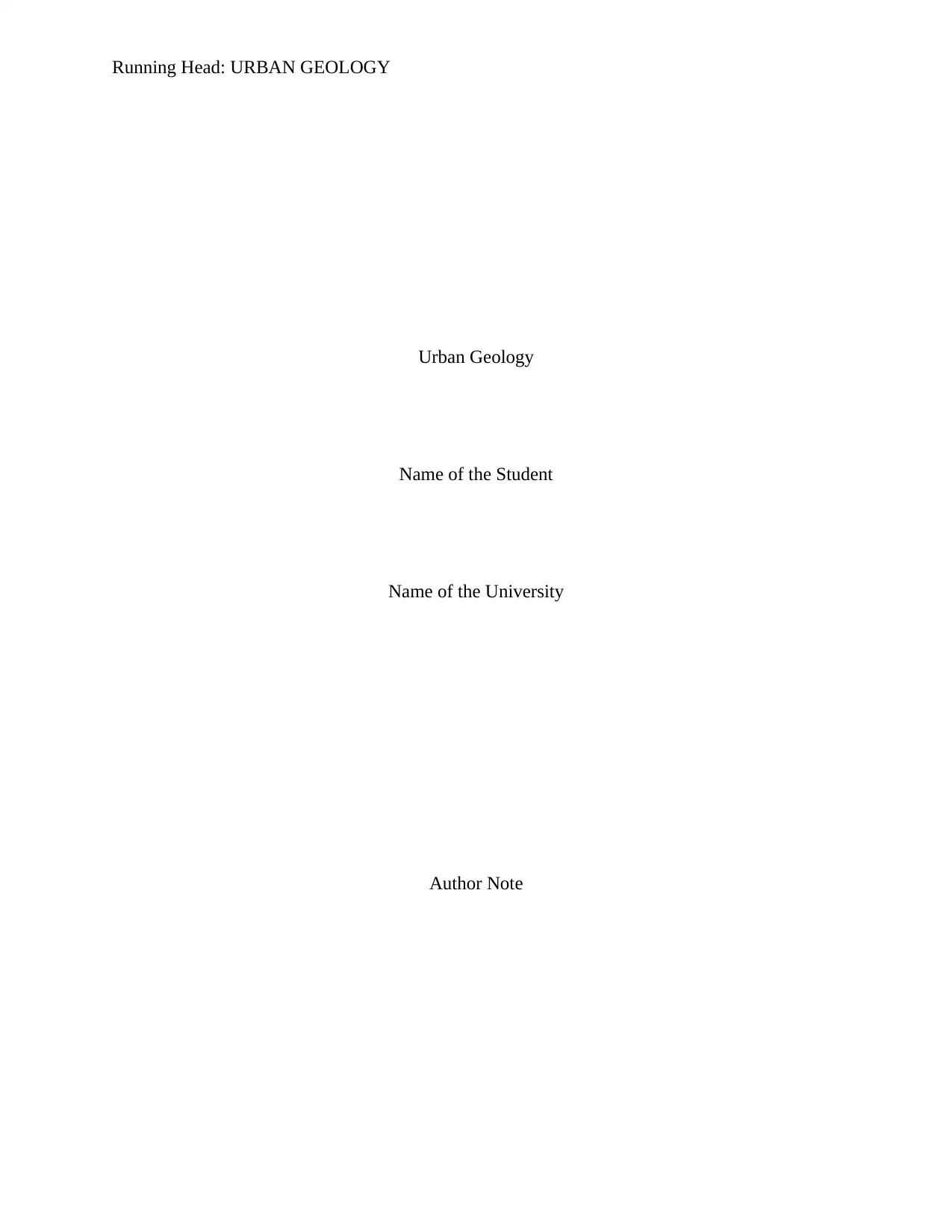
Running Head: URBAN GEOLOGY
Urban Geology
Name of the Student
Name of the University
Author Note
Urban Geology
Name of the Student
Name of the University
Author Note
Paraphrase This Document
Need a fresh take? Get an instant paraphrase of this document with our AI Paraphraser
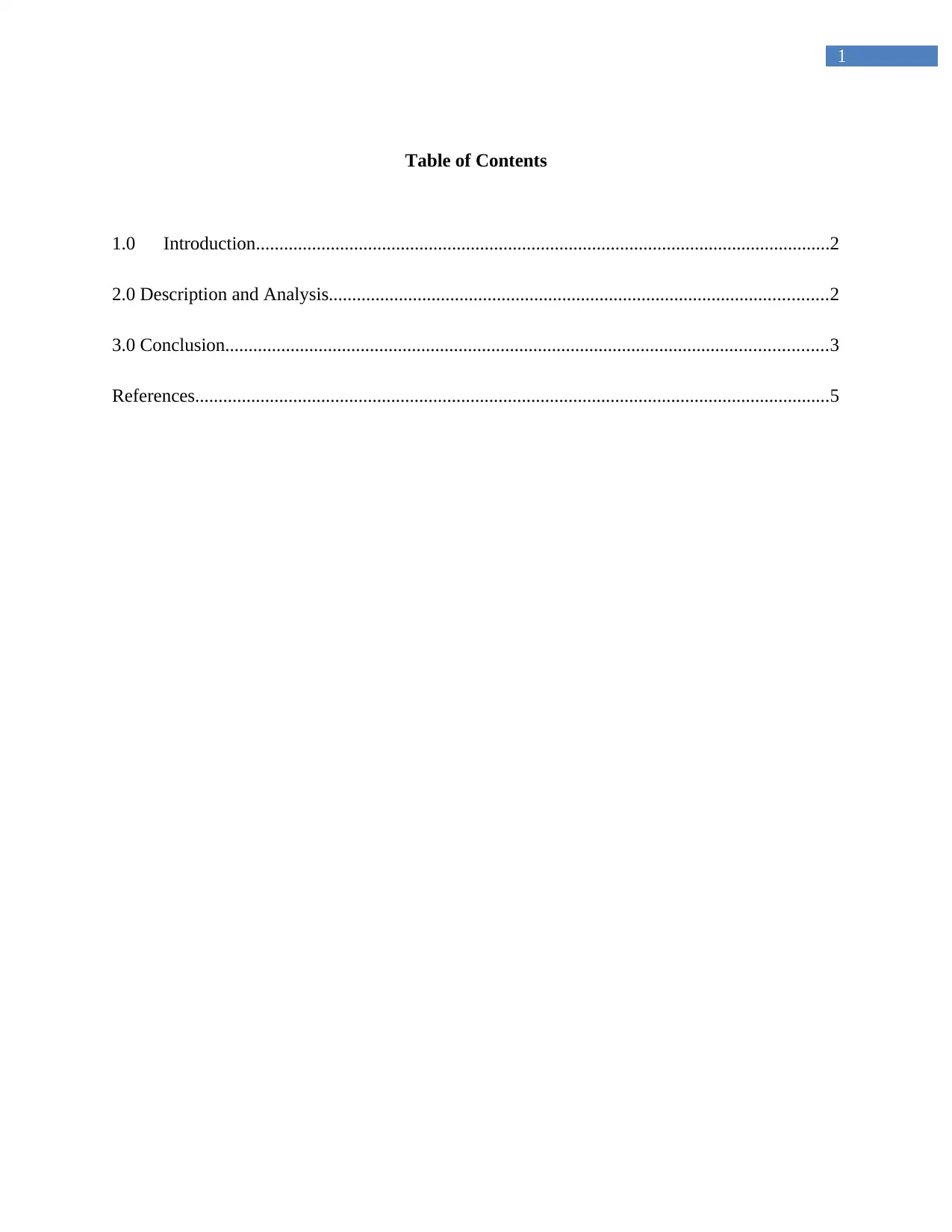
1
Table of Contents
1.0 Introduction...........................................................................................................................2
2.0 Description and Analysis...........................................................................................................2
3.0 Conclusion.................................................................................................................................3
References........................................................................................................................................5
Table of Contents
1.0 Introduction...........................................................................................................................2
2.0 Description and Analysis...........................................................................................................2
3.0 Conclusion.................................................................................................................................3
References........................................................................................................................................5
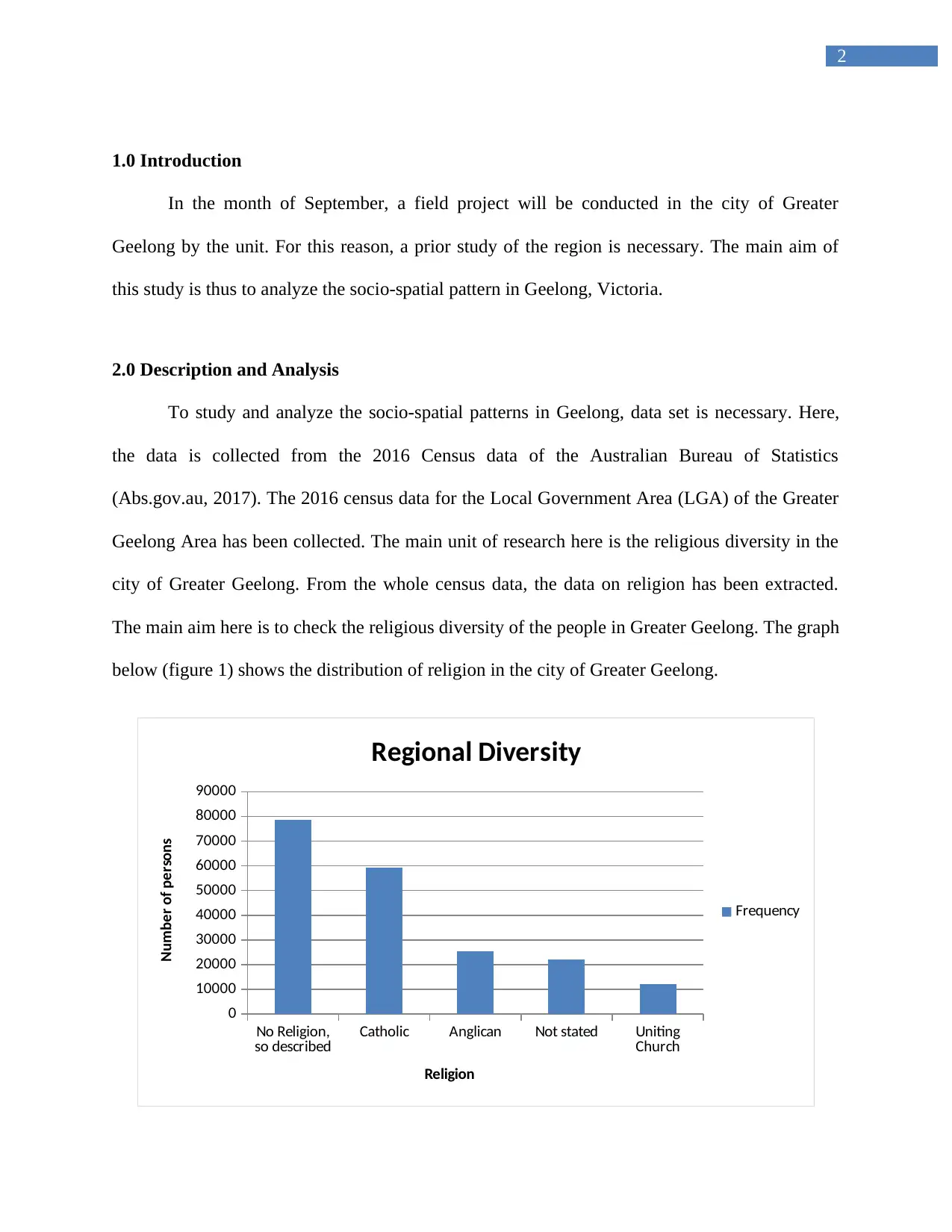
2
1.0 Introduction
In the month of September, a field project will be conducted in the city of Greater
Geelong by the unit. For this reason, a prior study of the region is necessary. The main aim of
this study is thus to analyze the socio-spatial pattern in Geelong, Victoria.
2.0 Description and Analysis
To study and analyze the socio-spatial patterns in Geelong, data set is necessary. Here,
the data is collected from the 2016 Census data of the Australian Bureau of Statistics
(Abs.gov.au, 2017). The 2016 census data for the Local Government Area (LGA) of the Greater
Geelong Area has been collected. The main unit of research here is the religious diversity in the
city of Greater Geelong. From the whole census data, the data on religion has been extracted.
The main aim here is to check the religious diversity of the people in Greater Geelong. The graph
below (figure 1) shows the distribution of religion in the city of Greater Geelong.
No Religion,
so described Catholic Anglican Not stated Uniting
Church
0
10000
20000
30000
40000
50000
60000
70000
80000
90000
Regional Diversity
Frequency
Religion
Number of persons
1.0 Introduction
In the month of September, a field project will be conducted in the city of Greater
Geelong by the unit. For this reason, a prior study of the region is necessary. The main aim of
this study is thus to analyze the socio-spatial pattern in Geelong, Victoria.
2.0 Description and Analysis
To study and analyze the socio-spatial patterns in Geelong, data set is necessary. Here,
the data is collected from the 2016 Census data of the Australian Bureau of Statistics
(Abs.gov.au, 2017). The 2016 census data for the Local Government Area (LGA) of the Greater
Geelong Area has been collected. The main unit of research here is the religious diversity in the
city of Greater Geelong. From the whole census data, the data on religion has been extracted.
The main aim here is to check the religious diversity of the people in Greater Geelong. The graph
below (figure 1) shows the distribution of religion in the city of Greater Geelong.
No Religion,
so described Catholic Anglican Not stated Uniting
Church
0
10000
20000
30000
40000
50000
60000
70000
80000
90000
Regional Diversity
Frequency
Religion
Number of persons
⊘ This is a preview!⊘
Do you want full access?
Subscribe today to unlock all pages.

Trusted by 1+ million students worldwide
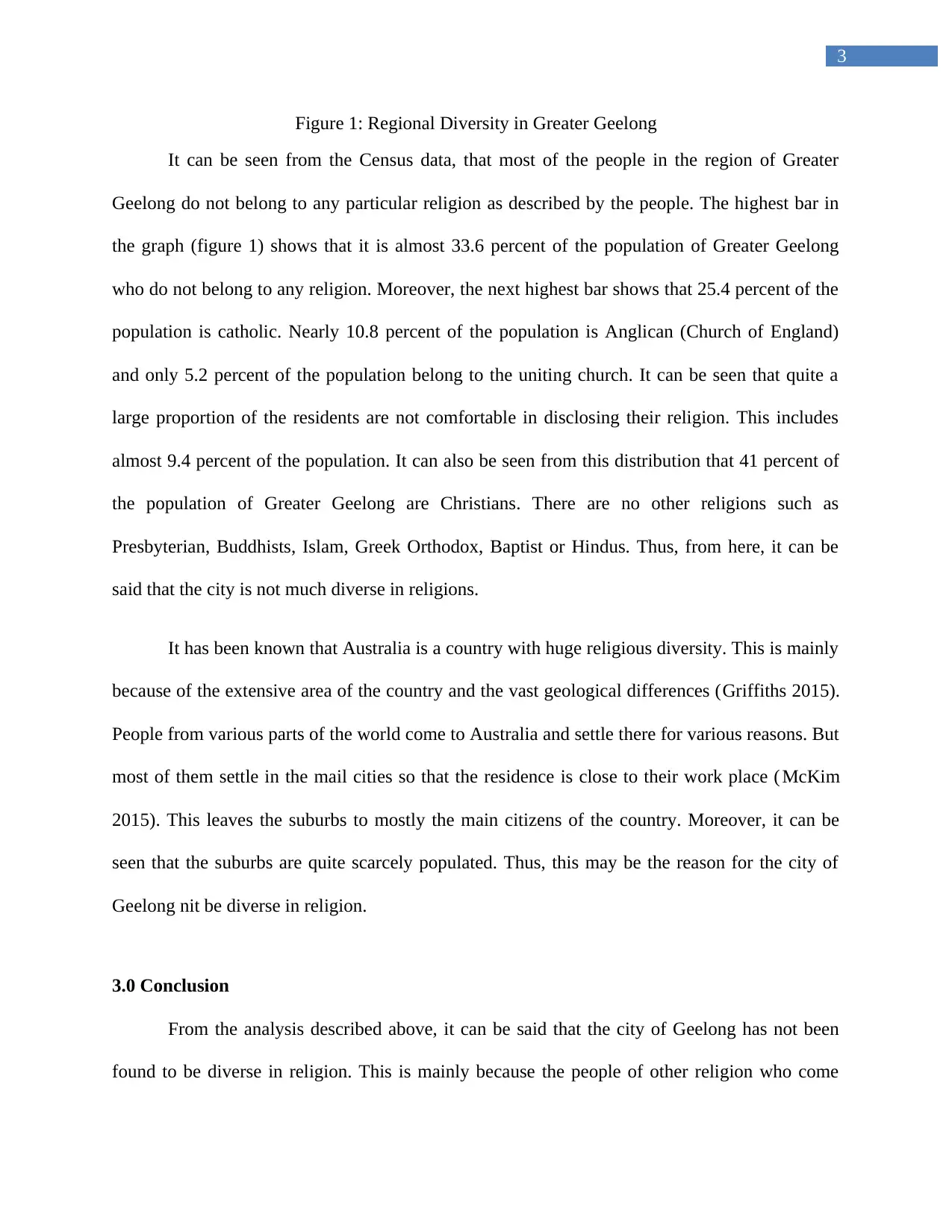
3
Figure 1: Regional Diversity in Greater Geelong
It can be seen from the Census data, that most of the people in the region of Greater
Geelong do not belong to any particular religion as described by the people. The highest bar in
the graph (figure 1) shows that it is almost 33.6 percent of the population of Greater Geelong
who do not belong to any religion. Moreover, the next highest bar shows that 25.4 percent of the
population is catholic. Nearly 10.8 percent of the population is Anglican (Church of England)
and only 5.2 percent of the population belong to the uniting church. It can be seen that quite a
large proportion of the residents are not comfortable in disclosing their religion. This includes
almost 9.4 percent of the population. It can also be seen from this distribution that 41 percent of
the population of Greater Geelong are Christians. There are no other religions such as
Presbyterian, Buddhists, Islam, Greek Orthodox, Baptist or Hindus. Thus, from here, it can be
said that the city is not much diverse in religions.
It has been known that Australia is a country with huge religious diversity. This is mainly
because of the extensive area of the country and the vast geological differences (Griffiths 2015).
People from various parts of the world come to Australia and settle there for various reasons. But
most of them settle in the mail cities so that the residence is close to their work place ( McKim
2015). This leaves the suburbs to mostly the main citizens of the country. Moreover, it can be
seen that the suburbs are quite scarcely populated. Thus, this may be the reason for the city of
Geelong nit be diverse in religion.
3.0 Conclusion
From the analysis described above, it can be said that the city of Geelong has not been
found to be diverse in religion. This is mainly because the people of other religion who come
Figure 1: Regional Diversity in Greater Geelong
It can be seen from the Census data, that most of the people in the region of Greater
Geelong do not belong to any particular religion as described by the people. The highest bar in
the graph (figure 1) shows that it is almost 33.6 percent of the population of Greater Geelong
who do not belong to any religion. Moreover, the next highest bar shows that 25.4 percent of the
population is catholic. Nearly 10.8 percent of the population is Anglican (Church of England)
and only 5.2 percent of the population belong to the uniting church. It can be seen that quite a
large proportion of the residents are not comfortable in disclosing their religion. This includes
almost 9.4 percent of the population. It can also be seen from this distribution that 41 percent of
the population of Greater Geelong are Christians. There are no other religions such as
Presbyterian, Buddhists, Islam, Greek Orthodox, Baptist or Hindus. Thus, from here, it can be
said that the city is not much diverse in religions.
It has been known that Australia is a country with huge religious diversity. This is mainly
because of the extensive area of the country and the vast geological differences (Griffiths 2015).
People from various parts of the world come to Australia and settle there for various reasons. But
most of them settle in the mail cities so that the residence is close to their work place ( McKim
2015). This leaves the suburbs to mostly the main citizens of the country. Moreover, it can be
seen that the suburbs are quite scarcely populated. Thus, this may be the reason for the city of
Geelong nit be diverse in religion.
3.0 Conclusion
From the analysis described above, it can be said that the city of Geelong has not been
found to be diverse in religion. This is mainly because the people of other religion who come
Paraphrase This Document
Need a fresh take? Get an instant paraphrase of this document with our AI Paraphraser
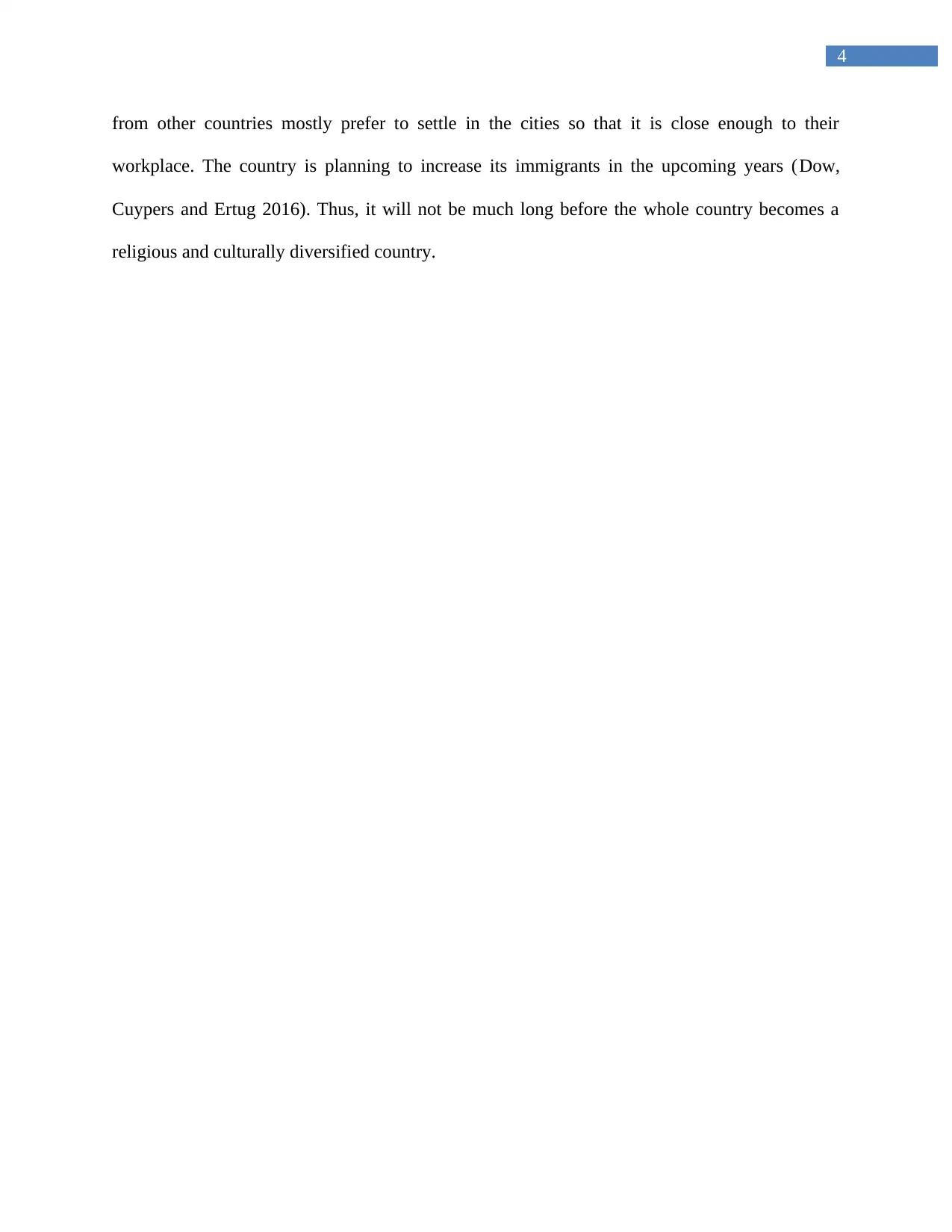
4
from other countries mostly prefer to settle in the cities so that it is close enough to their
workplace. The country is planning to increase its immigrants in the upcoming years (Dow,
Cuypers and Ertug 2016). Thus, it will not be much long before the whole country becomes a
religious and culturally diversified country.
from other countries mostly prefer to settle in the cities so that it is close enough to their
workplace. The country is planning to increase its immigrants in the upcoming years (Dow,
Cuypers and Ertug 2016). Thus, it will not be much long before the whole country becomes a
religious and culturally diversified country.
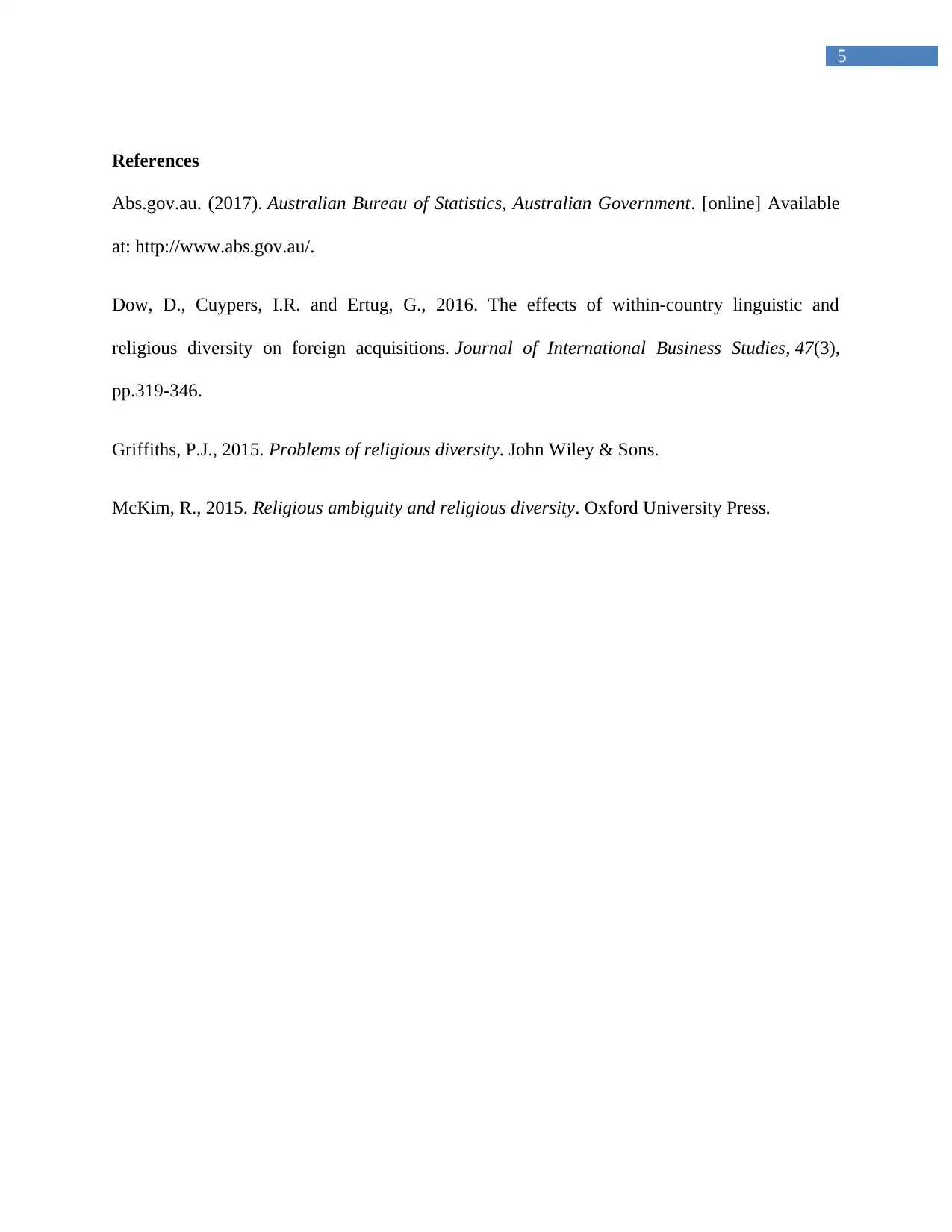
5
References
Abs.gov.au. (2017). Australian Bureau of Statistics, Australian Government. [online] Available
at: http://www.abs.gov.au/.
Dow, D., Cuypers, I.R. and Ertug, G., 2016. The effects of within-country linguistic and
religious diversity on foreign acquisitions. Journal of International Business Studies, 47(3),
pp.319-346.
Griffiths, P.J., 2015. Problems of religious diversity. John Wiley & Sons.
McKim, R., 2015. Religious ambiguity and religious diversity. Oxford University Press.
References
Abs.gov.au. (2017). Australian Bureau of Statistics, Australian Government. [online] Available
at: http://www.abs.gov.au/.
Dow, D., Cuypers, I.R. and Ertug, G., 2016. The effects of within-country linguistic and
religious diversity on foreign acquisitions. Journal of International Business Studies, 47(3),
pp.319-346.
Griffiths, P.J., 2015. Problems of religious diversity. John Wiley & Sons.
McKim, R., 2015. Religious ambiguity and religious diversity. Oxford University Press.
⊘ This is a preview!⊘
Do you want full access?
Subscribe today to unlock all pages.

Trusted by 1+ million students worldwide
1 out of 6
Your All-in-One AI-Powered Toolkit for Academic Success.
+13062052269
info@desklib.com
Available 24*7 on WhatsApp / Email
![[object Object]](/_next/static/media/star-bottom.7253800d.svg)
Unlock your academic potential
Copyright © 2020–2025 A2Z Services. All Rights Reserved. Developed and managed by ZUCOL.
